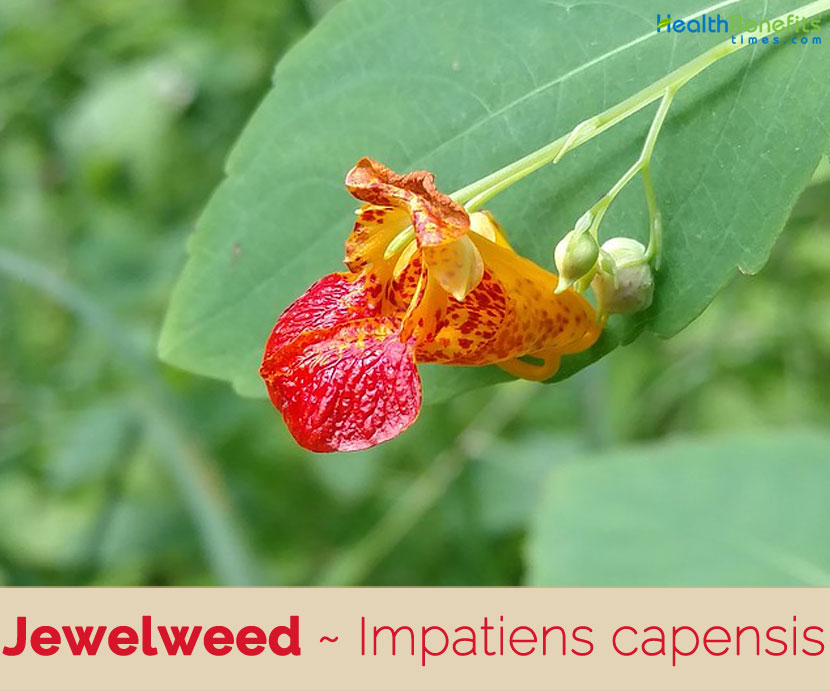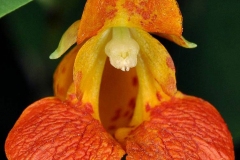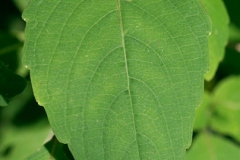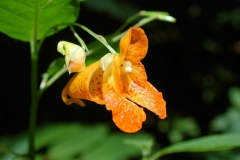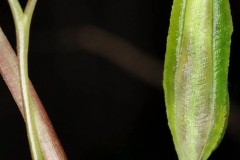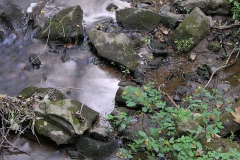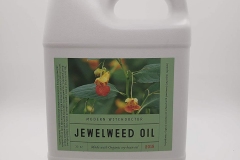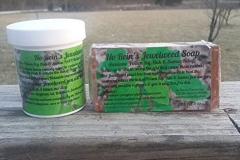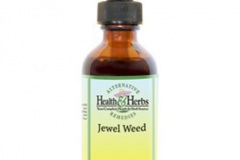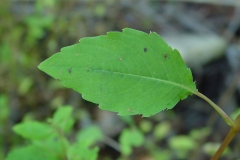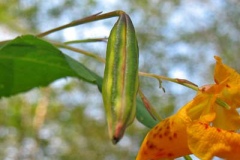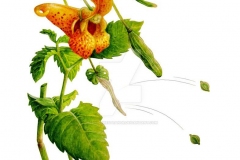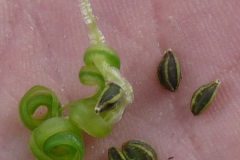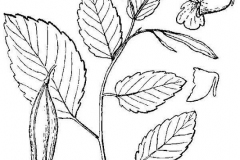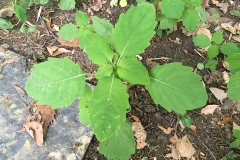| Jewelweed Quick Facts | |
|---|---|
| Name: | Jewelweed |
| Scientific Name: | Impatiens capensis |
| Origin | Eastern North America |
| Colors | Pale green |
| Shapes | Small narrow capsule about an inch long and divided into five sections |
| Taste | Acrid, bitter, burning taste |
| Health benefits | Good for fevers, difficult urination, measles, stomach cramps, jaundice, piles, athlete's foot, bee, nettle stings, hives, herpes, blisters, hemorrhoids, acne |
| Name | Jewelweed |
|---|---|
| Scientific Name | Impatiens capensis |
| Native | Eastern North America (but considered invasive in the Pacific Northwest |
| Common Names | Garden balsam, Jewel balsam weed, Jewel weed, Jewelweed, Touch-me-not, Wild Balsam, Balsam-weed, Impatiens pallida, Pale-touch-me-not, Spotted touch-me-not, Slipperweed, Silverweed, Wild Lady’s Slipper, Speckled Jewels, Wild Celandine, Quick-in-the-hand |
| Name in Other Languages | Danish: Canadisk balsamin Dutch: Oranje springzaad, Kaaps springzaad English: Jewelweed, cape touch-me-not, lady’s-earrings, snapweed, Spotted Jewelweed, Spotted Touch-Me-Not, Orange Balsam, Orange touch-me-not, Touch-me-not , Orange jewelweed, spotted snapweed Finnish: Lännenpalsami French: Impatiente du Cap, Balsamine du Cap, chou sauvage, impatiente biflore, Balsamine orange, Chou sauvage, balsamine orangée German: Orangefarbenes Springkraut, Kap-Springkraut, Orangerotes Springkraut Norwegian: Kanadaspringfrø Persian: گل دماغه Polish: Niecierpek pomarańczowy, Niecierpek przylądkowy Russian: Nedotroha kapskaya (недотрога капская) Swedish: Apelsinbalsamin, Lännenpalsami Welsh: Ffromlys oren |
| Plant Growth Habit | Tall, erect herbaceous plant |
| Growing Climates | Along the banks of rivers and canals, in low-lying moist woodlands, wet woodland borders, shaded riverbanks, roadside ditches, bottomland soils, along creeks, lake, pond, and stream edges, swamp forests, marshes, stream banks, margins of beaver ponds, marshy areas, thickets, ravines often in slightly disturbed areas, including excavations |
| Soil | Easily grown in medium to wet soils in part shade to full shade |
| Plant Size | 2 to 5 ft. (0.6-1.5 m) tall |
| Root | Shallow root system |
| Stem | Round stems are glabrous (smooth) and succulent, and semi-translucent, with swollen or darkened nodes on some plants |
| Leaf | Elliptic-ovate leaves are 1 to 3 inches long and up to 1½ inches wide |
| Flowering season | July to October |
| Flower | Flower is about 1 inch long and ½ to ¾ inch wide, tube or funnel shaped with a long narrow spur at the back with upper and lower lips |
| Fruit Shape & Size | Small narrow capsule about an inch long and divided into five sections |
| Fruit Color | Pale green |
| Seed | Seeds are longer than wide, brown with lighter ridges with a warty surface and usually number 3 to 5 per pod |
| Propagation | By seed |
| Taste | Acrid, bitter, burning taste |
| Plant Parts Used | Leaves, seed, stem |
| Available Forms | Fresh plant, a tea, tincture, oil ointment |
Plant Description
Common jewelweed is a tall, erect herbaceous plant that normally grows about 2 to 5 ft. (0.6-1.5 m) tall. The plant is found growing along the banks of rivers and canals, in low-lying moist woodlands, wet woodland borders, shaded riverbanks, roadside ditches, bottomland soils, along creeks, lake, pond, and stream edges, swamp forests, marshes, stream banks, margins of beaver ponds, marshy areas, thickets, ravines often in slightly disturbed areas, including excavations. The plant is easily grown in medium to wet soils in part shade to full shade. It is best in wet, humusy soils in part shade. The plant has shallow root system. Round stems are glabrous (smooth) and succulent, and semi-translucent, with swollen or darkened nodes on some plants. They are rather fragile and break easily. It excludes juice when broken.
Leaves
The elliptic-ovate leaves are 1 to 3 inches long and up to 1½ inches wide. They are arranged alternately, meaning that they emerge from the stem one leaf per node. Like the stems, they are hairless and somewhat succulent. The leaf has a distinct leaf stalk. The leaf edges have low, widely-spaced teeth. Petioles are 2-4 cm. long.
The leaves are covered with a coating that repels water. Water drops usually roll off the leaves, but in horizontal areas, the water beads up, appearing like jewels in the reflected light. When submerged in water, the leaves take on a silvery sheen. The function of this waterproofing is unknown.
Flowers
From the axils of the upper leaves, there occur small clusters of 1-3 orange flowers. These flowers are held horizontally on drooping pedicels. Each flower is about 1 inch long and ½ to ¾ inch wide, tube or funnel shaped with a long narrow spur at the back with upper and lower lips. There are 3 sepals and 5 petals (although this is difficult to distinguish). Two lateral sepals are small and membranous; they are light green to light yellow and are located behind the upper lip. The third sepal forms the conical posterior of the flower, including the small nectar spur. This portion of the flower is typically light orange and shiny; the nectar spur usually bends forward to a position underneath the rest of the flower. The petals form the front of the flower and are usually dark orange with reddish streaks or brown dots. One petal forms the upper lip, which is curved upward, while 2 fused petals form the lower lip. The lower lip often is divided into 2 lobes and functions as a landing pad for visiting insects. There are also 2 smaller lateral petals between the upper and lower lips of the flower. A cluster of stamens with white anthers lies beneath the ovary near the upper lip. The blooming period occurs from mid-summer to early fall, and lasts about 2 months. There is no floral scent.
Fruits
Fertile flowers are followed by small narrow capsule about an inch long and divided into five sections. They are pale green colored capsule. They split apart when touched, throwing seeds in all directions. The seeds are longer than wide, brown with lighter ridges with a warty surface and usually number 3 to 5 per pod. The seeds are dormant through the winter, germinating in April and May.
Traditional uses and benefits of Jewelweed
- Jewelweed was commonly used as a medicinal herb by a number of native North American Indian tribes, and has been extensively used in domestic medicine.
- Its main value lies in its external application for wounds and a range of skin complaints.
- However, it is little used in modern herbalism and is considered to be dangerous and ‘wholly questionable’ when used internally.
- The herb is antidote, cathartic, diuretic and emetic.
- An infusion has been used in the treatment of fevers, difficult urination, measles, stomach cramps, jaundice etc.
- Juice of the leaves is used externally in the treatment of piles, fungal dermatitis, nettle stings, poison ivy rash, burns etc.
- The sap is used to remove warts.
- A poultice of the leaves is applied to bruises, burns, cuts etc.
- Jewelweed is most commonly known for its antipruritic use in the treatment of poison ivy rash.
- It has also been used as an agent to encourage blood flow, for post childbirth and joint pain, bruises and swelling, and as an antidote to fish poisoning.
- Jewelweed has long been recognized as an herbal remedy for the treatment of topical irritation, most notably for the treatment of poison ivy rash.
- Sap of the jewelweed has been used by American Indians, mostly those living in Appalachia, as a prophylactic against poison ivy rash and as a treatment after the eruptions has occurred.
- The Southern Cherokee, Potawatomi, Chippewa, Meskwaki, and Omaha used I. capensis for a variety of pruritic dermatitis besides treating and preventing poison ivy rash and itch, including treatment of stings from other plants (e.g., stinging nettle) and insect bites.
- Juice of the corolla from white balsamina flowers is painted on the skin as an antipruritic in Japan.
- Aerial parts have been used in Chinese herbal medicine for treating pain and swelling, and as an antimicrobial.
- Aerial parts of the plant are used in Chinese herbal medicine for rheumatism, beriberi, bruises, pain, and swelling, and as an antimicrobial agent.
- Impatiens seeds have been used to promote blood flow, including menstruation, and for the suppression of post-childbirth pain, as an expectorant and, in some Asian countries, as an antidote for fish poisoning.
- Stem juice has also been used to treat athlete’s foot; its fungicidal qualities have been scientifically verified.
- The Cherokee used an infusion of the leaf for measles.
- The Chippewa applied a poultice of bruised stems to rashes and other skin troubles.
- The Iroquois used a cold infusion of plants for fevers.
- It can help repel an itchy and uncomfortable case of athlete’s foot.
- Ice cubes made from tea are also rubbed topically on rashes.
- Jewelweed was used for other skin eruptions related with bee stings, nettle stings, hives, herpes, blisters, hemorrhoids, acne and burns.
- Jewelweed has also been used in the form of infusions (strong tea) internally for headache, stomach ache, kidney problems and externally for bruises, muscle sprains and soreness.
Culinary Uses
- The succulent stems, whilst still young and tender can be cut up and cooked like green beans.
- Young leaves and shoots can be consumed after being cooked.
- Young sprouts can be eaten.
Other Facts
- The fresh juice obtained from the plant is a fungicide.
- This juice can be concentrated by boiling it.
- A yellow dye has been made from the flowers.
- It can be made from the whole plant.
Precautions
- Regular ingestion of large quantities of these plants can be dangerous due to their high mineral content.
- It can be harmful raw but is destroyed by thoroughly cooking or drying the plant.
- People with a tendency to rheumatism, arthritis, gout, kidney stones and hyperacidity should take especial caution if including this plant in their diet.
- Jewelweed consists of calcium oxalate crystals which can cause severe adverse reactions in some people including coma and death, liver and kidney damage.
References:
https://www.itis.gov/servlet/SingleRpt/SingleRpt?search_topic=TSN&search_value=29182#null
https://pfaf.org/user/Plant.aspx?LatinName=Impatiens+capensis
http://www.missouribotanicalgarden.org/PlantFinder/PlantFinderDetails.aspx?kempercode=k490
https://www.drugs.com/npp/jewelweed.html
https://botanical.com/botanical/mgmh/j/jewelw08.html
https://plants.usda.gov/core/profile?symbol=imca
https://en.wikipedia.org/wiki/Impatiens_capensis
https://wildadirondacks.org/adirondack-wildflowers-spotted-touch-me-not-impatiens-capensis.html
https://gd.eppo.int/taxon/IPACA


